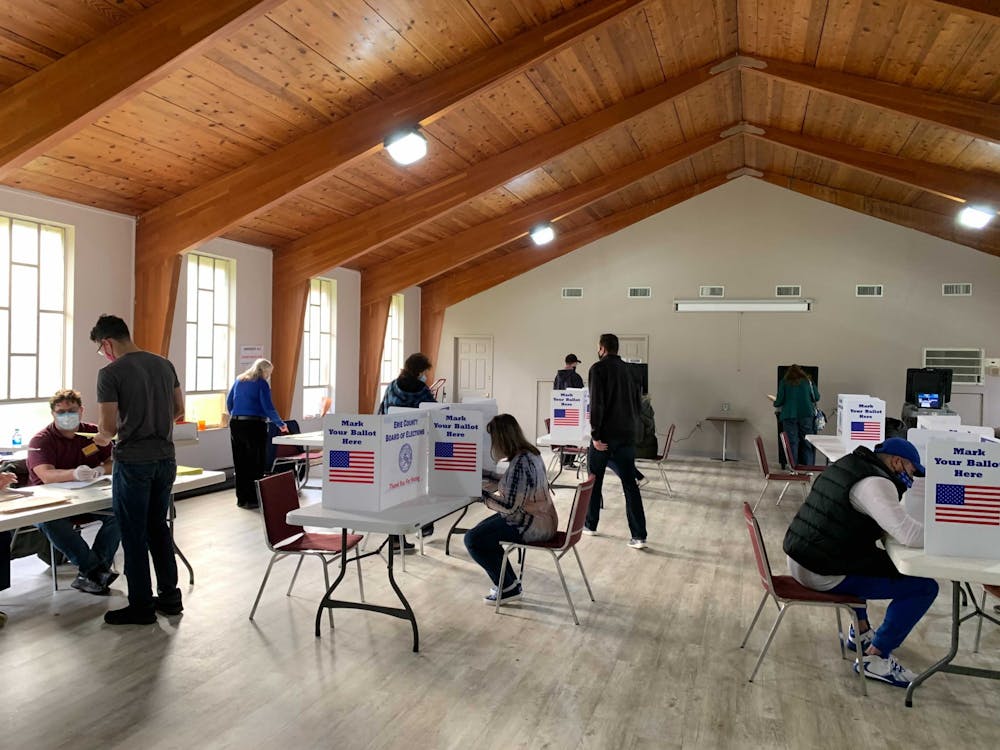Krish Patel often thought of what it would be like to vote in his first presidential election.
He imagined he’d vote at his local municipality building, where a friendly worker would direct him to a line extending out the door. He’d wait there for about half an hour and chat with an impatient stranger to pass the time.
The process would be relatively quick and painless: an easy segue into adulthood and civic engagement.
But the reality of election day — mask-clad voters stationed six-feet apart, socially-distanced privacy booths and the massive amounts of hand sanitizer — defied nearly all of Patel’s pre-Election Day expectations.
Patel, a freshman physics major, joined hundreds of first-time UB voters who endured long wait times at the polls for fear that their mail-in ballots might not be counted. Last week, President Trump warned that the federal government’s decision to permit states to mail ballots to all registered voters would lead to “mayhem” and fraud in “big unsolicited ballot states.” Mail-in voting practices, which date back to the Civil War, were also the target of myriad social media attacks alleging fraudulent ballot counting and ballot burning in key swing states. The allegations, compounded with the stresses and uncertainties of first-time voting, left many students wondering whether their voices would be heard.
Francesca Battista, a freshman pharmacy major, drove 85 miles from campus to her hometown of Webster, NY to cast her ballot on an early voting day the weekend before Nov. 3. She says her prior negative experiences with the United States Postal Services made her hesitant to vote by mail.
“I don’t really trust the mail,” said Battista. “I’ve had things less important than a ballot lost in the mail.”
Battista’s decision to vote in-person, however, was not without its own challenges. Long lines at the polls nearly prevented Battista and her family members from casting their ballots.
“We went in the morning right when [voting] started, but there was still a long line, and we ended up waiting an hour and a half in line outside,” Battista said.
Although students who voted by mail avoided the inconveniences encountered by their peers who voted at the polls, they too worried about the process of mail-in voting.
Carolyn Myka, a freshman nursing major from the Syracuse area, feared more than just mail-worker malfeasance.
“I sent [my ballot] two to three weeks ago, so I have full faith that it'll get there,” Myka said. “But I don’t entirely trust the president we have now, and I would not put it past him to make some sort of — I don’t even know what — that would cause some absentee ballots to get lost.”
Postal system gaffes are not entirely uncommon. On Nov. 5, a USPS mail carrier carrying 800 pieces of undelivered mail was arrested after accidentally making a wrong turn onto the U.S. Canada border, according to the Buffalo News. Border Protection agents found a bin of mail addressed to several zip codes and three absentee ballots sent out by the Erie County Board of Elections.
First-time voters also worried about following their ballot’s instructions and feared their ballots, if marked incorrectly, might face rejection by election officials.
According to statistics from CIRCLE research center at Tufts University, as of today, nearly 10 million young people, ages 18-29, have voted early or absentee in the 2020 election. The risk of ballot fraud, however, was assessed at 0.00004% to 0.0009%, according to The Brennan Center for Justice’s 2017 study of past elections.
Justin Froese, a freshman accounting major from Long Island, thought he’d avoid the long lines at the polls and the trouble of updating his home address on his voter registration form by requesting a mail-in ballot. Driving home for the election, like Battista, was not an option for Froese, who was too busy with his heavy course load to make the 400-mile trip downstate.
Froese was ecstatic when he first received an envelope with what he thought to be his ballot in the mail. But moments later, he realized the ballot actually belonged to his roommate.
The freshman realized he entered the wrong address on his mail-in ballot request form.
“Well, I was an idiot,” Froese said, “The people in the mailing [room] had no idea what [my address] was, and probably sent [my ballot] to someone who wasn’t me.”
Froese felt it was too late to request a new ballot and decided not to vote.
Alexis Krayevsky, a freshman biochemistry major, was excited to vote in her first presidential election and “nervous” to make any mistake on her mail-in ballot that might prevent her vote from being counted.
“I was a little bit nervous about [mailing in my ballot] because I was like, ‘Is it actually going to get there,’” Krayevsky said.
The news desk can be reached at news@ubspectrum.com
Elizabeth "Liz" Napolitano is the senior news editor for The Spectrum. She's an optimistic pessimist who found her love for journalism in Ecuador. She likes late night walks and reading Twitter threads in their entirety.

Grant Ashley is the editor in chief of The Spectrum. He's also reported for NPR, WBFO, WIVB and The Buffalo News. He enjoys taking long bike rides, baking with his parents’ ingredients and recreating Bob Ross paintings in crayon. He can be found on the platform formerly known as Twitter at @Grantrashley.





